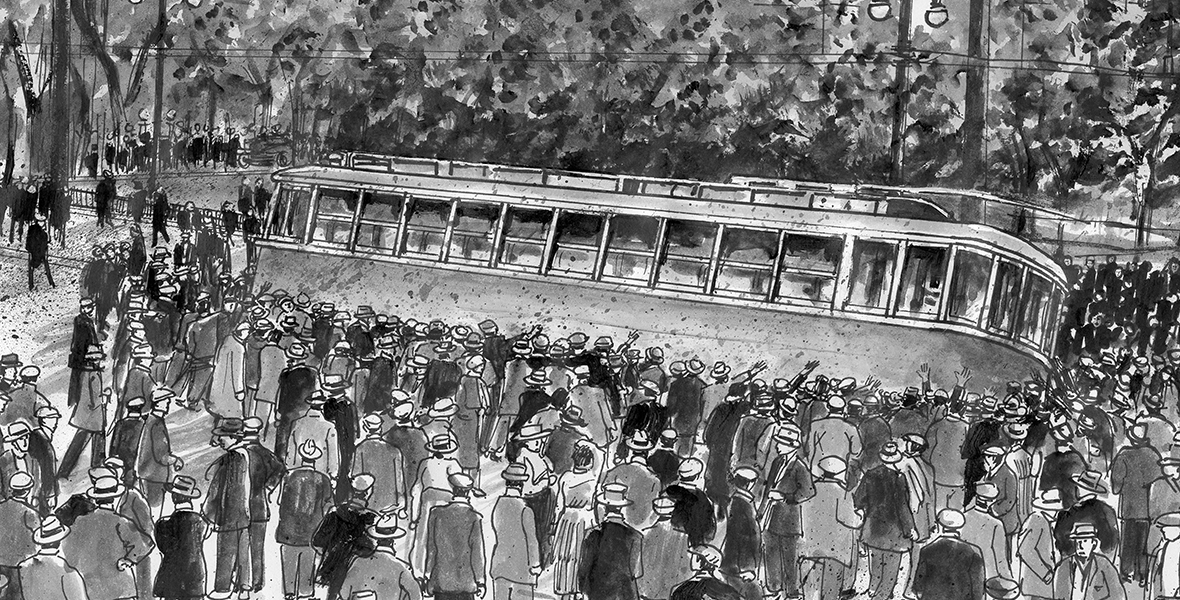1919, a new graphic novel by The Graphic History Collective and David Lester, is a welcome addition to all the ways that the 100th anniversary of the Winnipeg General Strike is being marked. The strike, which began on May 15 and ended on June 26 of 1919, is being commemorated in Winnipeg with a variety of events. These dinners, lectures, concerts and historical tours will be complemented greatly by this educational contribution to such an important anniversary and the ongoing class struggle that the 1919 strike was such a classic example of in the history of Canada, and the history of workers in general.
The Graphic History Collective, founded in 2008, is a group of artists writers, activists and researchers who “are passionate about comics, history, and social change.” Their goal is to make the history of class struggle accessible in a format that helps the people of the present understand the historical roots of contemporary issues. In addition to various comics on certain issues or actions, they have published other books such as May Day: A Graphic History of Protest in Canada, and Drawn to Change: A Graphic History of Working Class Struggle.
1919 begins with a preface and introduction by James Naylor, each of which stress the importance of solidarity in a time when solidarity was being actively targeted by a commercial elite who headed up the opposition to the strike. Workers were encouraged to turn against the “foreign radicals,” “enemy aliens” and “Bolsheviks” that they claimed were in charge of the strike and seeking to overthrow the government.
Instead, as Naylor writes, these attempts “mostly fell flat,” in a victory for class politics that gives hope to those who see in elements of some of the identity politics of today an attempt, as it was then, to divert people from seeing who their real problem is with. Recent immigrants, women, British-born trade unionists, white railroaders, Black porters, thousands of returned soldiers, and even the police united behind their common interests, and a vision of Winnipeg and a wider world where a powerful few did not get to rule over the powerless many.
To some extent, 1919 suffers from the inherent limitation of comics, which is to say that it may not satisfy those who are students of the strike and are able to quarrel with some of the details, either included or omitted. Overall, however, the story is told well, and illustrated well. Having said this, given that approximately a third of the illustrated pictures in the book are devoted to Bloody Saturday, when mounted Royal North West Mounted Police charged a peaceful march, killing two citizens, I found myself wishing for fewer drawings without commentary and more opportunity for expanding the narrative.
A good addition to the Bloody Saturday section might have been a sketch of two boys up on a roof watching the scene below, as bullets whizzed over their heads, impressing upon them forever the nature of the brute force the state was willing to countenance using against people demanding fundamental change in the capitalist world order. One such boy was future CCF premier and federal NDP leader Tommy Douglas, as recounted in Tom McLeod’s biography of Douglas, The Road to Jerusalem. It is possible that the possibility of such a sketch was not known to 1919′s authors. But its absence is of a piece with no mention of the New Democratic Party as a part of the legacy of the strike, through the election after the strike of Woodsworth and Heaps, and the subsequent formation of the CCF, the NDP’s predecessor, which does get a mention.
In Winnipeg this June 25, just one day before the 100th anniversary of the strike’s conclusion, there will be a dinner and celebration of the 50th anniversary of Manitoba’s first NDP government, and first NDP premier, Ed Schreyer. His was a government that was routinely subjected by the Conservative opposition to variations of the same rhetoric and derision that the commercial elite of 1919 used against the strikers.
The Committee of 1000 was a largely nameless group of the powerful merchants and their lawyer cohorts who were organized to crush the strike, and who manipulated all levels of government into compliance with their will. Their successors always know who the NDP is. And they still don’t like it.
Bill Blaikie is a retired United Church minister, who served in the House of Commons as the MP for northeast Winnipeg from 1979 to 2008. In 2009 he was elected to the Manitoba ;egislature and was the minister of conservation from 2009 to 2011. In 2011 his political memoir, The Blaikie Report: An Insider’s Look at Faith and Politics, was published by United Church Publishing House. He is currently an adjunct professor of theology and politics at the University of Winnipeg, and recently began writing a monthly column for rabble.ca.



